You’ve probably noticed that the internet is overflowing with information about the GMAT. In most cases, the data is old and outdated, and this can be more confusing than helpful.
You’re probably searching for a single, reliable source that can simplify the GMAT Focus Edition for you. After all, the GMAT is a crucial exam for admission into top MBA programs both in India and around the world, and you need to have the latest and most relevant data, right?
Great! This blog is made just for readers like you!
In this blog, we will talk about:
2. GMAT Focus Eligibility and Scheduling
3. GMAT Focus Structure and Content
- What is the duration and format of the GMAT Focus Edition?
- What is the section order selection in the GMAT Focus Edition?
- What is the GMAT Focus Edition syllabus?
- What is tested on the GMAT Focus Verbal Section?
- What is tested on the GMAT Focus Quant Section?
- What is tested on the GMAT Focus Data Insights Section?
4. GMAT Focus Preparation and Study Material
6. Acceptance and Reporting Scores
Grab your free copy of ‘Demystifying GMAT Focus Edition’
What is the GMAT Focus Edition?
The GMAT, short for Graduate Management Admission Test, is the test for entry into more than 7,700 MBA and business-related programs offered by over 2,400 universities and institutions across 114 countries globally.
Over the last decade, the test, which is administered by the Graduate Management Admission Council (GMAC), has evolved significantly to better meet the needs of those aiming for a business or management degree.
The latest version, the GMAT Focus Edition, is now the only version of the GMAT that is available as of January 31st, 2024. This version further tailors the GMAT to the evolving needs of both MBA aspirants and business schools, making sure each candidate is thoroughly assessed as a future business leader in the rapidly changing business landscape.
Why was the GMAT Focus Edition introduced?
The GMAT Focus Edition was introduced to address several key factors in the evolving landscape of graduate business education and standardized testing.
- Certain question types, such as Sentence Correction and Geometry, have become less relevant in the business world.
- The high level of exposure and practice had led to a saturation of top scores on the quant section of the old GMAT.
- The Analytical Writing Assessment (AWA) section has become redundant because AI tools can now be used for any kind of writing.
- There’s a growing preference and increased competition from the GRE.
The GMAT Focus Edition focuses on critical reasoning and data literacy skills, which are more relevant in modern business environments. This test provides a more efficient and insightful assessment that clearly indicates a candidate’s readiness and fit for the dynamic business world.
How is the GMAT Focus Edition different from the traditional GMAT?
There are seven main differences between the GMAT Focus Edition and the traditional GMAT.
1. Three sections instead of four: The old GMAT had four sections: Analytical Writing Assessment (AWA), Integrated Reasoning (IR), Quantitative Reasoning, and Verbal Reasoning. The new GMAT has three sections: Quantitative Reasoning, Verbal Reasoning , and Data Insights (DI)
2. No AWA Section: The GMAT Focus edition does not have the AWA section. This means that the candidates do not have to worry about writing an essay any more.
3. No Sentence Correction Questions: Many candidates considered Sentence Correction questions the toughest question types in the Verbal section of the classic GMAT. These question types have now been removed.
4. No Geometry Questions: Even though there were only about 5 to 6 geometry questions in the traditional GMAT, a lot of prep was needed to learn to tackle these questions. The test setters have recognized that geometry isn’t very crucial in the business world and have removed this question type from the GMAT Focus Edition test.
5. Fewer Questions and Lesser Time: In the traditional version, a total of 79 questions had to be completed in 3 hours and 7 minutes. In the GMAT Focus, a total of 64 questions need to be completed in 2 hours and 15 minutes.
| Section Name | Questions | Duration |
|---|---|---|
| Quantitative Reasoning | 21 | 45 minutes |
| Verbal Reasoning | 23 | 45 minutes |
| Data Insights | 20 | 45 minutes |
| Total | 64 | 2 hours and 15 minutes |
6. Bookmark and Edit Questions: Test takers can now bookmark a question and revisit that question at the end of a section. They can even change up to 3 answers per section. This was not possible in the traditional GMAT.
7. Select colleges after the exam: Test takers can send their scores to up to 5 colleges for free. In the classic version, test takers were expected to select schools before taking the test. The new GMAT version allows test takers to first view their scores and then choose colleges where their chances of getting admitted, based on their scores, are greater.
What are the key features of the GMAT Focus Edition?
Choosing your own test order: You can now pick the order in which you want to take the test. This means you can start with the part you are strongest at or save it for the end. This flexibility helps you do your best because you can plan your test based on what works best for you.
Bookmarking, Reviewing, and Editing Answers: You can bookmark questions, review any question you want, and even change the answers of up to three questions in each section of the test. This helps you make sure you’re satisfied with your choice and gives you a chance to fix any mistakes before you finish the test.
Deciding where to send scores after seeing the scores: After you finish the test, the total scores and section scores will appear on the screen. You can then choose which five business schools you want to send the scores to based on your score. This gives you the chance to send your scores only to those schools where you think you have the best chance.
Get a Free Detailed Report: You’ll get an Official Score Report within 3-5 days after your test, and it’s free. This report gives you a lot of details about how you did on each part of the test. It can help you understand your strengths and where you might need to improve. This information is really helpful, especially if you plan to take the test again.
Is the GMAT Focus Edition difficult?
Yes, the GMAT Focus Edition is considered harder overall compared to the classic GMAT. The Graduate Management Admission Council (GMAC) predicts that only 1 percent of test-takers will score above 705 on the GMAT Focus Edition.
This suggests that achieving top scores on this new version of the test is more difficult, making it harder to stand out during the admissions process.
The difficulty of the GMAT Focus Edition compared to the Classic GMAT depends on individual strengths. Some find the GMAT Focus Edition easier because it doesn’t have Geometry and Sentence Correction questions. This means they don’t need to spend as much time getting ready as they would for the Classic GMAT.
However, some find the GMAT Focus Edition difficult because it has the new Data Insights section, which is unfamiliar and time-consuming.
How hard the GMAT Focus Edition feels can also depend on what you studied in school and how you like to learn. For example, people who studied science, technology, engineering, and math (STEM) might find the math parts easier.
Similarly, people with a business or commerce background might like the Focus Edition because a lot of questions are based on the understanding of data.
But, people who studied arts or humanities might find it harder because there’s a lot of analysis to do.
What is the eligibility for taking the GMAT Focus Edition?
The GMAC has not set any strict eligibility criteria for the GMAT Focus Edition, but candidates must be at least 18 years old or have parental consent if aged between 13-17. There is no upper age limit to take the GMAT.
Evaluate your fitment For GMAT Focus Edition
How can I take the GMAT Focus Edition?
The GMAT Focus Edition can be taken at any time throughout the year.
There are two formats available for taking the GMAT Focus Edition:
1. Traditional Test Center-based GMAT Exam, where the exam is taken at a designated test center.
2. Online Proctored GMAT Exam, where a secure online platform is used to take the exam remotely, typically from your home.
Rest assured, business schools will consider your scores official and valid, whether you took the test online or at a test center.
However, keep in mind that some B-schools only accept GMAT test scores if the exam was taken at a test center. Make sure you check your chosen B-schools’ requirements before you book and take the GMAT.
Let’s look at the pros and cons of both formats.
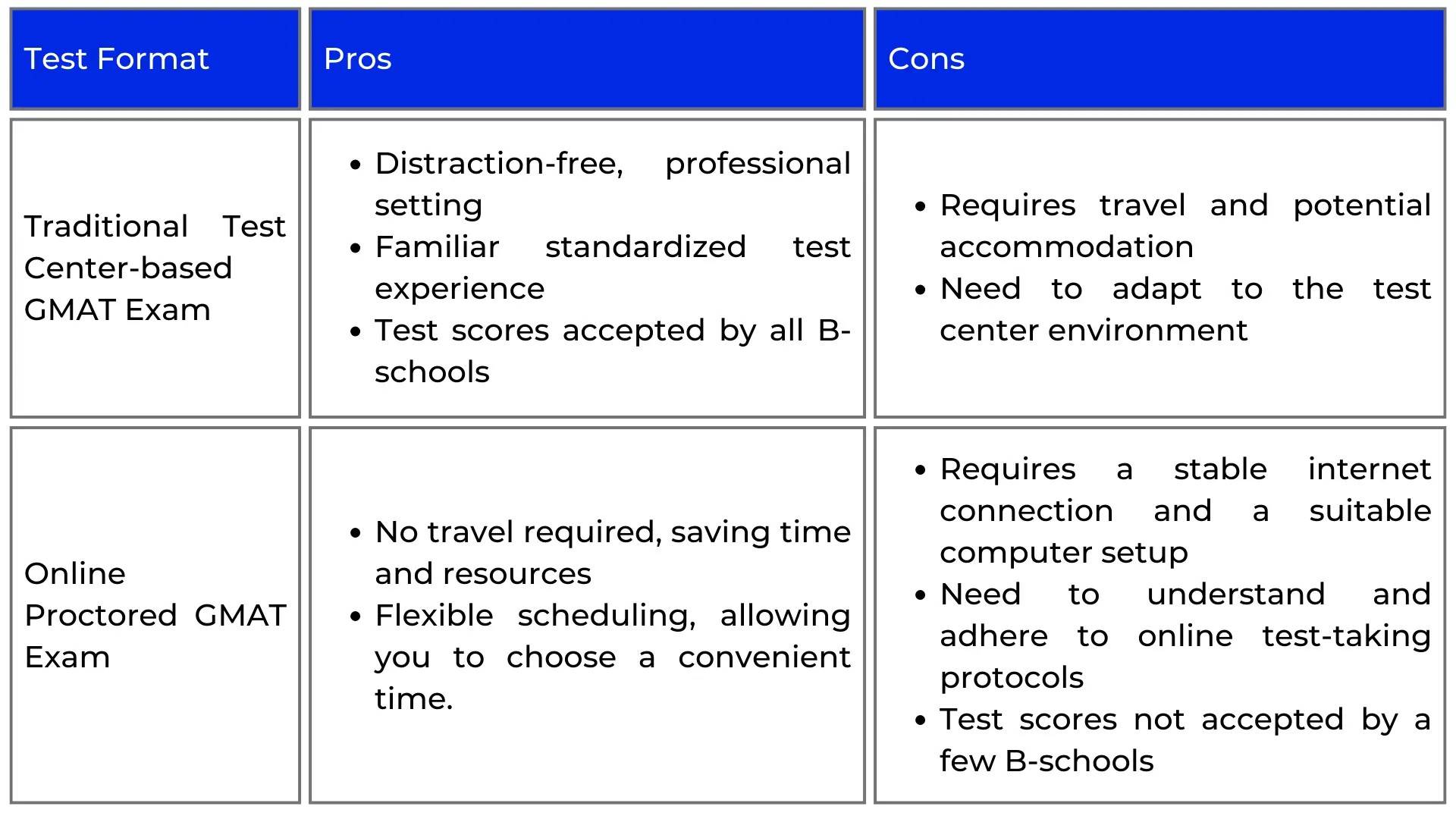
When can I take the GMAT Focus Edition?
The GMAT Focus Edition offers unique flexibility in scheduling, unlike exams like CAT that have fixed dates.
Candidates can take the GMAT Focus exam on any day that suits them. In most test centers, time slots are available from 8 in the morning to 4:30 in the evening.
Online test slots are available 24/7. Whether you’re an early bird, a night owl, or a full-time worker with limited availability, you can book a slot at any time. This makes online testing a highly accessible and adaptable option for individuals with diverse schedules and commitments.
Grab your free copy of ‘Demystifying GMAT Focus Edition’
Grab your free copy of ‘Demystifying GMAT Focus Edition’
Are there any charges to cancel or reschedule the new GMAT exam?
Rescheduling Fees:
Rescheduling fees depend on how close your new exam date is to the original date. If you reschedule more than 60 days before the exam, the fee is low.
However, the closer it gets to the exam day, the higher the fees. Therefore, if you need to reschedule, it’s better to do it as soon as possible to save money.
| When you reschedule | Test Center | Online |
|---|---|---|
| More than 60 days before | $55 | $60 |
| 15–60 days before | $110 | $120 |
| Less than 14 days before | $165 | $180 |
Cancellation Refund Amount:
Just like with rescheduling, if you need to cancel your test, it’s better to do it as early as possible to save money. If you cancel close to the exam date, the exam fee refund will be very low. So, no matter what the plan, decide soon!
| When you cancel | Test Center Refund | Online Refund |
|---|---|---|
| More than 60 days before | $110 | $120 |
| 15–60 days before | $80 | $90 |
| Less than 14 days before | $55 | $60 |
How often can I retake the GMAT Focus Edition?
You can retake the GMAT up to 5 times in a calendar year and up to 8 times in a lifetime.
However, there is a minimum 16-day gap required between attempts.
While this gap can seem like an obstacle for those who are keen to retake the test, this gap ensures that candidates have adequate time to address any areas of weakness before retaking the exam.
What is the duration and format of the GMAT Focus Edition?
| Section | No. of Questions | Duration of the Section | Question Types |
|---|---|---|---|
| Verbal Reasoning | 20 | Reading Comprehension, Critical Reasoning | 45 min |
| Quant Reasoning | 21 | Problem Solving - Algebra & Arithmetic, Data Sufficiency | 45 min |
| Data Insights | 23 | Multi-source Reasoning, Table Analysis, Graphics Interpretation; Two-Part Analysis | 45 min |
| One optional 10-minute break between any two sections | |||
What is the section order selection in the GMAT Focus Edition?
In the GMAT Focus Edition, test-takers can choose the order in which they complete the three main sections: Quantitative Reasoning (Quant), Verbal Reasoning (Verbal), and Data Insights. Each section is 45 minutes long, with a single 10-minute break available.
Here are the six section order options you can select:
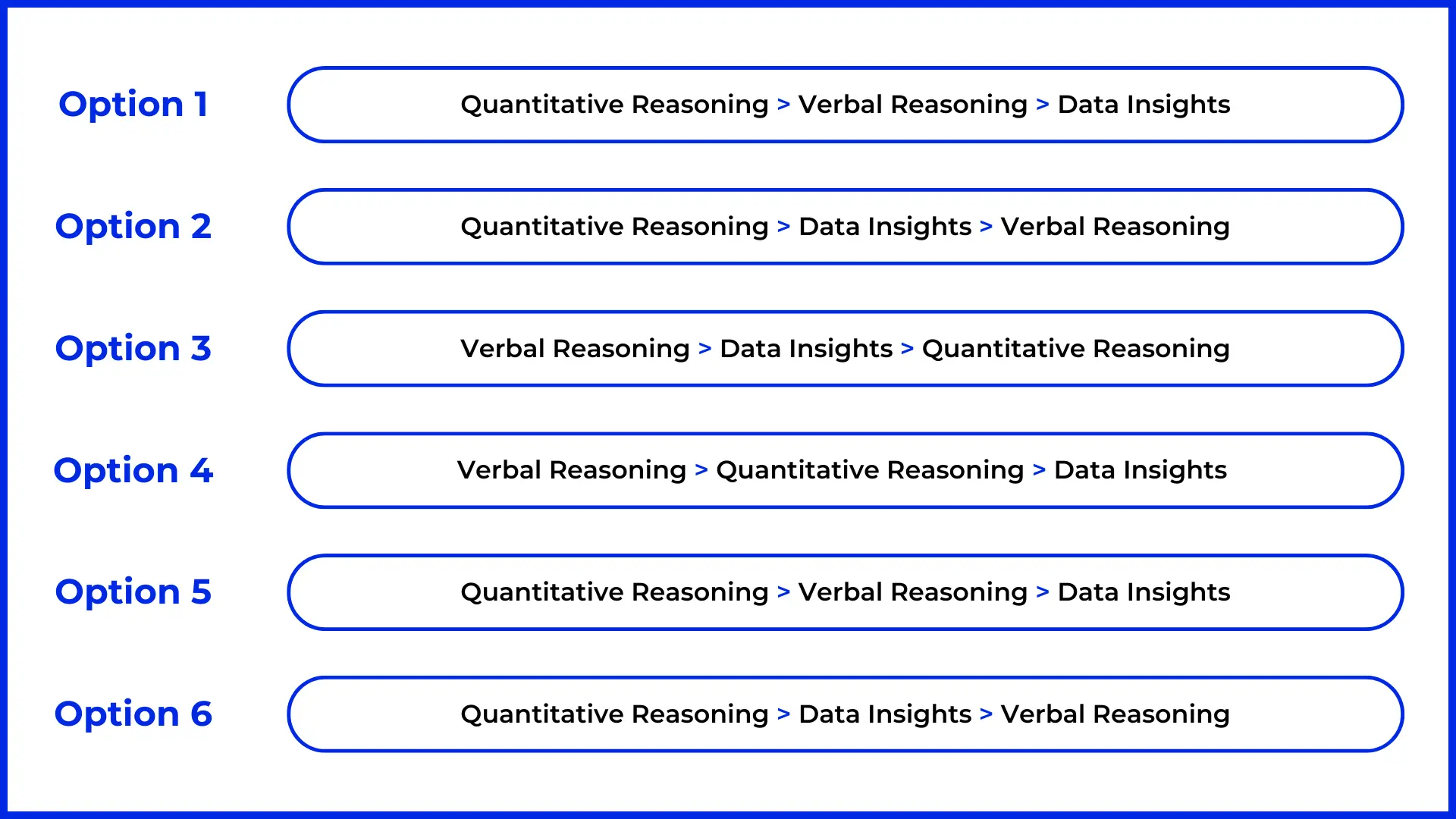
What is the GMAT Focus Edition syllabus?
The GMAT Focus Edition consists of three main sections:
- Verbal Reasoning
- Quantitative Reasoning
- Data Insights
| Section | No. of Questions | Duration of the Section | Question Types |
|---|---|---|---|
| Verbal Reasoning | 23 | 45 minutes | Reading Comprehension, Critical Reasoning |
| Quant Reasoning | 21 | 45 minutes | Algebra, Arithmetic, Data Sufficiency |
| Data Insights | 20 | 45 minutes | Multi-source Reasoning, Table Analysis, Graphics Interpretation, Two-Part Analysis |
Find out more details about the GMAT Focus Syllabus.
What is tested on the GMAT Focus Edition Verbal Section?
The Verbal Reasoning section of the GMAT Focus Edition consists of 23 questions that need to be completed within 45 minutes.
Question Types and Distribution
The section includes a mix of Reading Comprehension and Critical Reasoning questions, with each question type making up 40% to 50% of the section
Reading Comprehension
In the Reading Comprehension subsection, candidates will encounter 3 to 4 passages, each followed by 3 to 4 questions that test comprehension and interpretation skills
The key skills tested include:
- Understanding the main idea and supporting details
- Inferring information from the passage
- Analyzing the structure and purpose of the passage
- Identifying the author’s tone and attitude
Critical Reasoning
The Critical Reasoning subsection presents candidates with 9 to 10 questions that require evaluating arguments, identifying assumptions, and understanding logical connections
The key skills assessed include:
- Analyzing the logical structure of arguments
- Identifying premises, conclusions, and assumptions
- Strengthening and weakening arguments
- Drawing logical inferences
What is tested on the GMAT Focus Edition Quant Section?
The Quantitative section of the GMAT Focus Edition consists of 21 questions to be completed within 45 minutes.
The Quantitative section covers a wide range of topics, including:
- Arithmetic: Basic operations, percentages, ratios, and proportions
- Algebra: Equations, inequalities, functions, and graphing
- Geometry: Shapes, angles, areas, and volumes
- Data Analysis: Interpretation of data sets, statistics, and probability
Question Types and Distribution
The Quantitative section is divided into different question types with varying distributions:
Problem Solving (50% – 60%): These questions require candidates to solve mathematical problems using reasoning skills.
Data Sufficiency (40% – 50%): These questions test candidates’ ability to analyze data and determine whether the information provided is sufficient to answer the question.
What is tested on the GMAT Focus Edition Data Insights Section?
The Data Insights section of the GMAT Focus Edition consists of 20 questions to be completed within 45 minutes.
The Data Insights section covers a range of topics, including:
- Data Sets and Types: Qualitative and quantitative data analysis
- Data Displays: Tables, qualitative charts, and quantitative charts
- Data Patterns: Distributions, trends, and correlations
Question Types and Distribution
The Data Insights section includes various question types with different distributions:
- Multi-Source Reasoning: These questions expect candidates to analyze information from multiple sources
- Table Analysis: In this question type, candidates have to interpret data presented in tabular form
- Graphics Interpretation: In these questions, candidates have to understand data presented in a graphical format
- Two-Part Analysis: In these questions, candidates have to solve problems that involve two components
What study material should I use for the GMAT Focus Edition?
Make sure you only use official material for your GMAT preparation. This will ensure that the questions you practice are as similar as possible to the questions that will be presented in the actual exam.
Official GMAC resources use material that is very close to the structure, content, and level of the actual test. Unofficial materials may not match the real test’s questions and could confuse you.
Here’s a list of the official material you can use:
- GMAT™ Focus Official Starter Kit: This kit provides an excellent starting point for familiarizing yourself with the new exam format. It includes Practice Exams 1 & 2 and concept reviews for Quantitative, Verbal, and Data Insights sections.
- GMAT™ Official Guide 2023-2024 and GMAT™ Official Guide 2024-2025: Each of these guides features over 800 real GMAT questions for comprehensive practice and preparation.
- GMAT™ Focus Official Prep: This resource offers a sampler of 70 real GMAT questions and guided study plans. It also includes two full-length practice exams (GMAT Focus Practice Exams 1 & 2).
- Additional Official Mock Tests: These additional tests are available for further practice for those who have already attempted Test 1 and 2.
While having the best resources is half the battle won, studying with a mentor is the best route to going all the way. Be it studying with a bunch of peers or hitting the books with a dedicated mentor, we have you covered.
Talk to one of our expert GMAT advisors
How should I study for the GMAT Focus Edition?
To prepare effectively for the GMAT Focus Edition test, consider the following study strategies:
Utilize Official GMAT Focus Edition Resources: Take advantage of the GMAT Focus Official Prep materials available on mba.com, including the ones mentioned in the earlier section. These resources are specifically tailored to help candidates succeed on the GMAT Focus Edition.
Incorporate Mock Exams: Incorporate mock exams into your study plan to simulate the test environment and assess your readiness for the exam. Mock exams can help you familiarize yourself with the format, timing, and question types of the GMAT Focus Edition and allow you to identify areas for improvement.
Establish a Study Schedule: Set a study schedule that works for you and your lifestyle, ensuring that you allocate sufficient time for preparation.
Focus on Question Types: Understand the question types included in each section of the GMAT Focus Edition, such as Data Sufficiency, Two-Part Analysis, Graphical Interpretation, Reading Comprehension, and Critical Reasoning. Tailor your study efforts to target these specific question types to enhance your performance.
Practice Regularly: Regular practice is key to improving your skills and familiarity with the exam content. Use official resources to refine your performance in sections where you need more practice.
How is the GMAT Focus Edition scored?
The GMAT Focus Edition has introduced a new scoring range to better assess skills relevant in the modern business world.
Each of the three sections (Quantitative Reasoning, Verbal Reasoning, and Data Insights) is scored on a scale from 60 to 90. This uniform scoring across sections emphasizes the equal importance of each area.
However, the GMAT Focus Edition gives more importance to percentile rankings. Percentile rankings indicate the percentage of test takers a candidate has outperformed.
For example, a 75th percentile ranking means the candidate scored higher than 75% of test takers.
Now let us look at the scores and the corresponding percentiles for each section.
This percentile table for the GMAT Focus Edition’s Verbal Reasoning section shows that you need to have a score well above the mean value of 78.99 to stand out.
For example, an increase from a score of 80 to 85 can catapult you from the 60th to the 96th percentile, indicating that small score improvements in the higher range can have a substantial impact on your percentile ranking.
In the GMAT Focus Quantitative Reasoning section, achieving a score slightly above the mean of 77.71 is significantly advantageous. For instance, if you moved from a score of 75 to 85, you would jump from the 35th percentile to the 89th percentile.
In the GMAT Focus Data Insights section, it is essential to go beyond the mean score of 74.41. The table shows that a significant percentile leap occurs between scores of 70 and 85, indicating that improvement in this range is highly valuable.
Achieving a score of 85 places you at the 99th percentile, almost the top of the candidate pool, showcasing exceptional proficiency in data analysis
Total Score Range:
In the GMAT Focus Edition, your final score will be the cumulative result of your performance across the three sections: Quantitative Reasoning, Verbal Reasoning, and Data Insights.
Each of these sections contributes to a total score that ranges from 205 to 805, an adjustment from the traditional 200-800 scale.
Note: All scores in the Focus Edition end in ‘5’ to set them apart from the classic GMAT scores.
To see how your individual section scores combine to form your total score, you can use the straightforward online calculator provided here: GMAT Focus Score Calculator.
The average GMAT Focus score so far is about 546. This means that half of the people score below this number and the other half score above it.
Also, if you get a higher score on the test, your percentile ranking compared to other test-takers jumps up a great deal.
For example, if you improve your score from 605 to 705, you move from the 75th percentile to the 98th percentile. So, a little improvement can make a big difference!
Have you already taken the GMAT, that is, the GMAT Classic Edition Test? Compare your scores to the Focus Edition.
What is considered a “good score” in the GMAT Focus Edition?
A “good score” on the GMAT Focus Edition depends on the requirements of each specific program and can vary significantly across different schools and programs.
Let us look at the “average” GMAT percentile at some of the top MBA programs globally (including India):
| MBA Program | Percentile Range |
|---|---|
| Stanford GSB | 96th |
| Harvard Business School | 96th |
| The Wharton School | 94th |
| Northwestern Kellogg | 96th |
| Chicago Booth | 94th |
| ISB (Indian School of Business) | 92nd |
| IIM A PGPX (IIM Ahmedabad) | 90th |
| INSEAD | 70th-94th |
| London Business School | 90th-96th |
Ok…all you need to do now is decide on the B-schools you’d like to apply to and compare the percentile range in these schools with the GMAT Focus Edition scores. Once you do this, you’ll know the approximate scores that these schools will consider a “good score.”
For example, suppose INSEAD is the school of your dreams. The range for this school is from the 70th to the 94th percentile. As per the conversion chart, you will need to score anywhere between 595 and 675 to have a fair chance at being accepted at INSEAD. The higher the score, the better your chances.
Broadly speaking, a score above 645 can be considered a fairly good score, but if you have your eyes set on one of the top-tier M7 schools, you’ll need a score of 685 and above.
Is there a score report available for the GMAT Focus Edition?
Yes, an Official Score Report is available for the GMAT Focus Edition. This report provides detailed performance insights, including total and section scores, percentile rankings, insights by section, question type, content domain, time management details, and performance comparison to others applying to the same program.
This report is accessible through your mba.com account within 3-5 days of completing the exam
How long are my GMAT Focus Edition score Valid?
Whether you plan to apply to business schools right away or decide to first gain professional experience or improve your qualifications, your GMAT Focus scores remain valid for a period of five years, starting from the date you took the exam.
This extended validity period offers you significant flexibility in planning your journey toward graduate education.
This timeframe also provides an opportunity to retake the exam if you wish to improve your scores.
Which business schools accept the GMAT Focus Edition scores?
Almost all the business schools worldwide now accept GMAT Focus Edition scores because it tests important skills for modern business.
The GMAT Focus Edition was redesigned with help from top business schools to focus on advanced reasoning and data skills. This makes it a valuable tool for assessing candidates’ readiness for graduate business programs.
In India, prestigious institutions like the Indian School of Business (ISB) and the Indian Institutes of Management (IIMs) accept GMAT Focus Edition scores for their admissions processes. However, it is important to note that these schools do not accept GMAT Focus online scores for admissions.
How can I send my GMAT Focus Edition scores to the business schools?
The exam fee includes the fee for sending your scores to five business schools. You do not need to worry about separately sending the scores. So relax 🙂
It’s a good idea, however, to be ready with your list of preferred schools before taking the GMAT Focus Edition. If you have this list handy, you can send your scores immediately after getting your scores.
If you score higher or lower than you expected and are not sure which school will work best for you, don’t worry. You have a window period of 48 hours after the test. You can discuss with the experts and then decide which schools or programs you want to send your scores to.
Keep in mind that you’ll need to pay an additional amount of $28 per school or program if you do not send your scores within the window period.
Let’s suppose you sent your scores within the window period and you want to send your scores to a few more schools or programs. You can do so by paying an additional amount of $28 per school or program.
Finally…
The GMAT Focus Edition is more than a mere test; it’s your strategic ally on the trail toward triumph in the competitive world of business education.
In this blog, we’ve explained what the GMAT Focus Edition really is, why it’s important, and what makes it different.
If you have more questions, get in touch. If you are looking for a clear picture of what you need to do to ace the GMAT Focus edition, talk to our advisors.

![GMAT Focus Editon – The Ultimate Guide [Updated 2024] GMAT Focus Editon - The Ultimate Guide [Updated 2024]](https://www.crackverbal.com/wp-content/uploads/2024/04/GMAT-FE-top.webp)







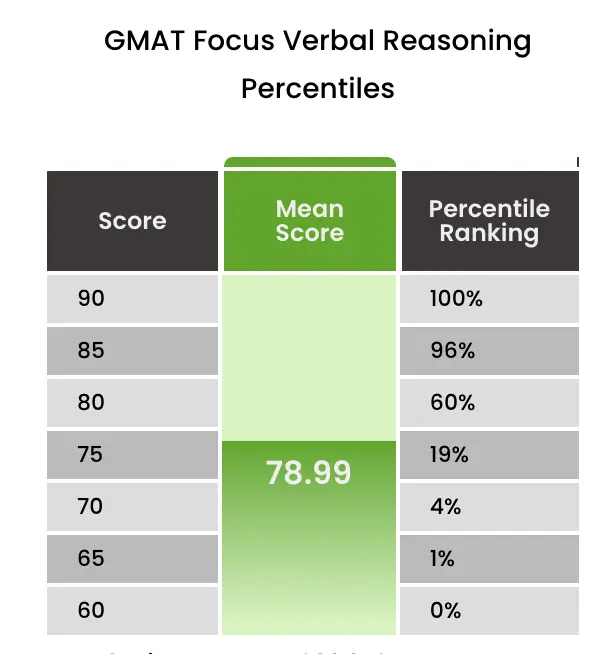
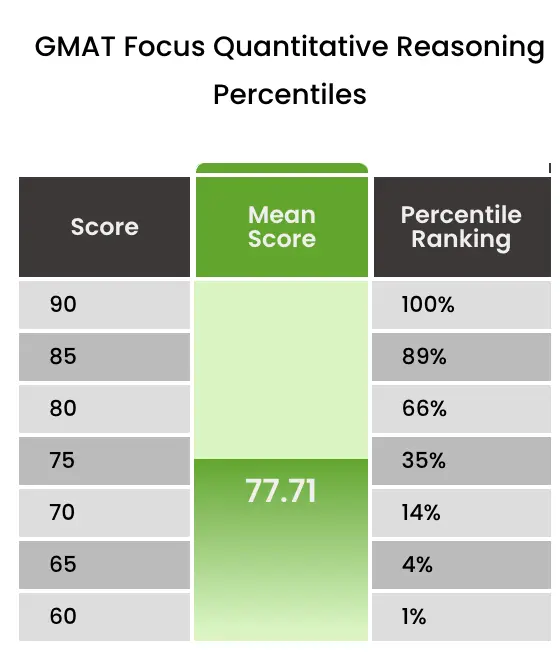
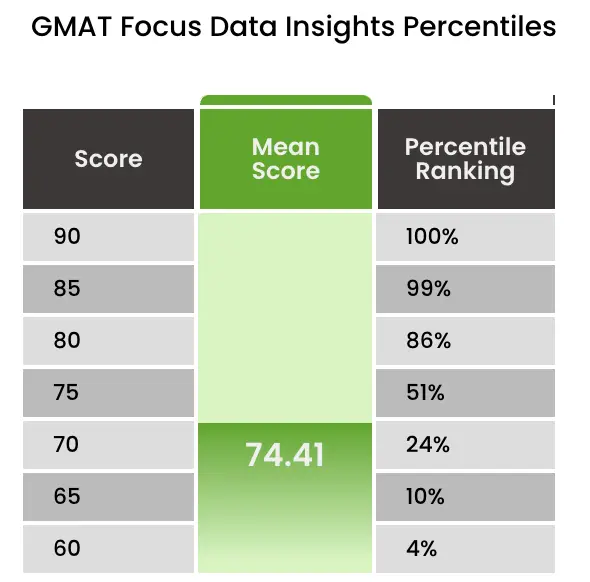
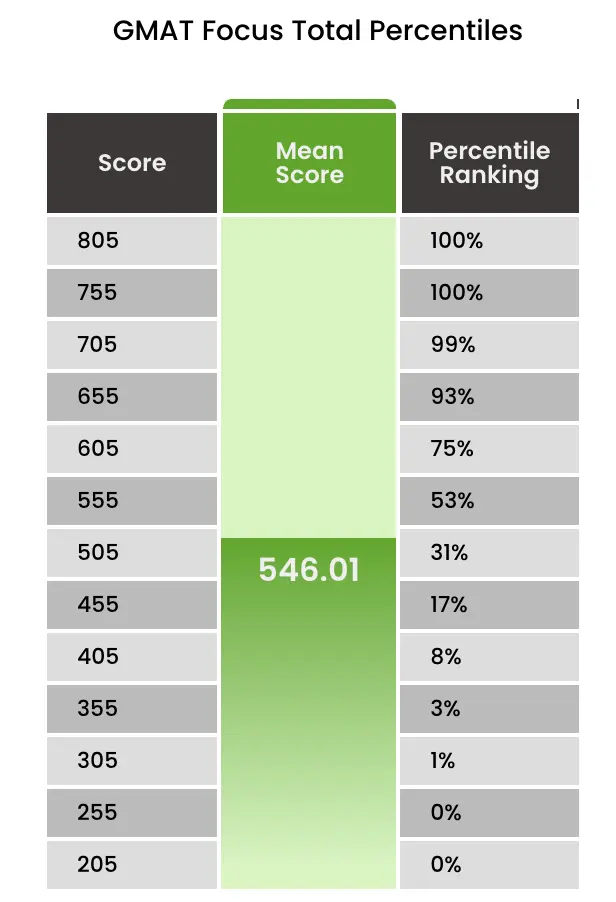
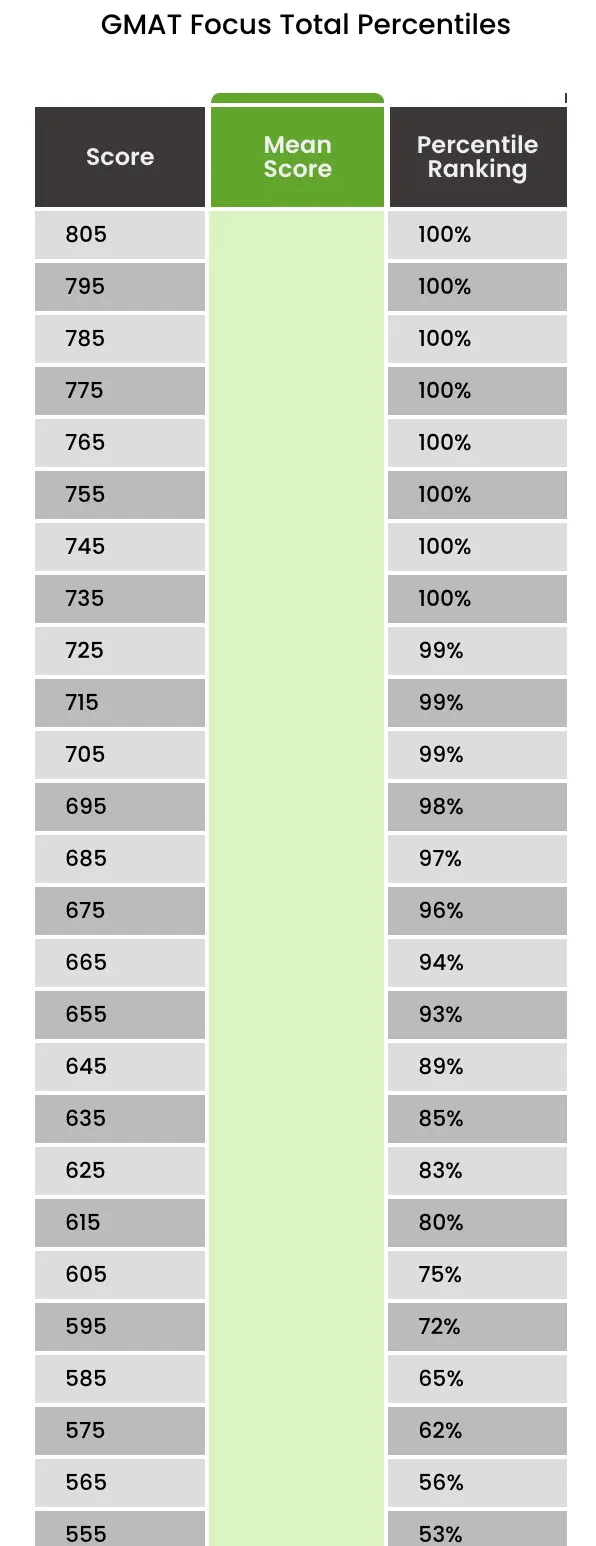



0 Comments